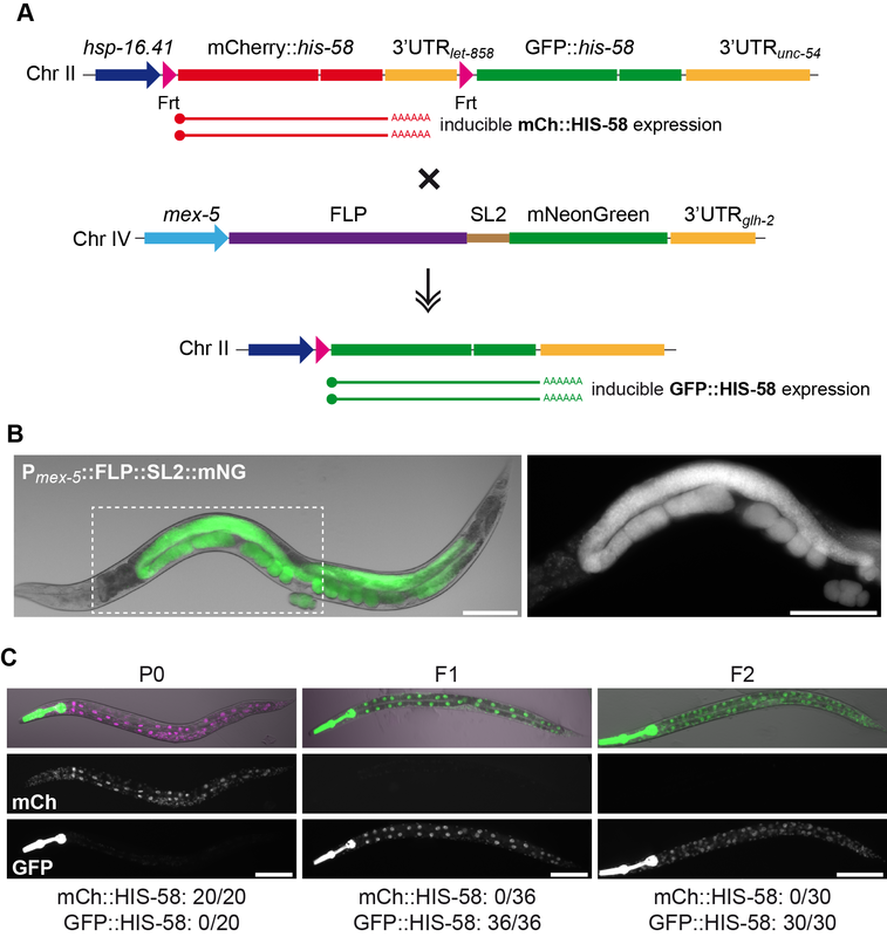Description
Recombinases are very useful enzymes for spatiotemporal control of gene expression (Hubbard 2014). Through binding to specific DNA sequences, they can be used to excise or exchange DNA fragments. We have previously generated a series of Caenorhabditis elegans strains that stably express an efficient FLP recombinase in specific tissues and reported how they enable precise regulation of gene expression, cell ablation or conditional gene knockout (Muñoz-Jiménez et al 2017). However, these strains are restricted to somatic tissues. Here we describe a novel strain that expresses FLP specifically in the germ line from an integrated single-copy transgene. Employing a dual color reporter, we found ~100% recombination efficiency, implying that the strain can be useful for a variety of experiments. This includes 1) induce germ-line expression of genes that have a negative effect on animal fitness (and thus are difficult or impossible to maintain as stably expressing strain); 2) permanently remove selectable markers flanked by Frt sites by easy crossing. For comparison, the elegant SapTrap toolkit for CRISPR/Cas9 genome modification relies on a loxP-flanked unc-119(+) transgene, whose removal requires injection of a Cre expression plasmid (Schwartz & Jorgensen 2016); 3) stable and precise knockout (KO) of genes flanked by Frt sites or tagged by a unique GFP KO cassette (Muñoz-Jiménez et al 2017).
To generate plasmid pBN396 for germ-line expression of FLP, we inserted a NotI+KpnI fragment from pBN179 Pmex-5::gfp::mel-28 (Gómez-Saldivar et al 2016) into pBN338 Pdat-1::FLP::SL2::mNG (Muñoz-Jiménez et al 2017) cut with the same enzymes. This fragment contains 486 base pairs immediately upstream of the mex-5 start codon (5’- atatcagtttttaaaaaatt…ttgaatgtttcagacagaga-3’).
Plasmid pBN396 contains an SL2 transplicing cassette between FLP and mNeonGreen (mNG), thus transcription from the mex-5 promoter produces a bi-cistronic pre-mRNA that encodes individual FLP and mNG proteins (Figure 1A). After sequence verification we injected pBN396 into EG6700 unc-119(ed3) III; cxTi10882 IV together with relevant plasmids for Mos1-mediated single-copy integration (Frøkjær-Jensen et al 2012), producing strain BN711 unc-119(ed3) III; bqSi711[pBN396(unc-119(+) Pmex-5::FLP::SL2::mNG)] IV. We demonstrated by PCR that the Mos1 transposon was not re-inserted elsewhere in the genome of BN711. Correct expression of FLP in the germ line was indirectly confirmed by co-expression of fluorescent mNG (Figure 1B). To evaluate recombination efficiency, we next crossed BN711 hermaphrodites with BN596 males, which carry a single-copy dual color reporter inserted in chromosome II and a pharyngeal GFP marker in the cxTi10882 locus on chromosome IV (Muñoz-Jiménez et al 2017; Figure 1A). F1 progeny were incubated at 34°C for 15 min followed by recovery at 20°C for 3 h and evaluated in a fluorescent stereoscope. All animals (n=36) had ubiquitous expression of GFP::HIS-58, whereas no expression of mCherry::HIS-58 was observed (Figure 1C middle panel). This suggested that the FLP enzyme had effectively induced recombination in all blastomers of the early embryo. We next analyzed F2 progeny produced by F1 self-fertilization and found again ubiquitous GFP::HIS-58 expression after heat induction, even in animals that did not inherit the FLP transgene (n=30; Figure 1C right panel). Together, this demonstrated that the FLP transgene efficiently induces germ-line recombination, which is stably propagated to subsequent generations.
In conclusion, we have developed an efficient addition to the FLP/Frt toolkit for C. elegans, enabling manipulation of gene expression in the germ line. The novel FLP plasmid and FLP line will be made available to the community trough Addgene (https://www.addgene.org) and the Caenorhabditis Genetics Center (https://cgc.umn.edu), respectively.
Reagents
Plasmid pBN396 (unc-119(+) Pmex-5::FLP::SL2::mNG).
Strain BN596 bqSi294[pBN154(unc-119(+) Phsp-16.41::FRT::mCh::his-58::FRT::gfp::his-58)] II; bqSi577[pBN306(unc-119(+) Pmyo-2::gfp)] IV.
Strain BN711 unc-119(ed3) III; bqSi711[pBN396(unc-119(+) Pmex-5::FLP::SL2::mNG)] IV.
References
Funding
This work was funded by the Spanish Ministry of Economy and Competitiveness (BFU2016-79313-P) and the European Regional Development Fund through a ‘Empleo Juvenil’ contract to J.M.-L. (Universidad Pablo de Olavide EJ04).
Reviewed By
Christian Frøkjær-JensenHistory
Received: March 15, 2018Accepted: March 18, 2018
Published: March 19, 2018
Copyright
© 2018 by the authors. This is an open-access article distributed under the terms of the Creative Commons Attribution 4.0 International (CC BY 4.0) License, which permits unrestricted use, distribution, and reproduction in any medium, provided the original author and source are credited.Citation
Macías-León, J; Askjaer, P (2018). Efficient FLP-mediated germ-line recombination in C. elegans . microPublication Biology. 10.17912/W2G66S.Download: RIS BibTeX




